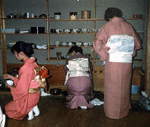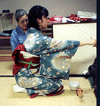
The Virtual Picture Album --Japan
The grid below is an annotated index to part of the Virtual Picture Album compiled and distributed by the Less Commonly Taught Languages Project at the University of Minnesota. The pictures in this section of the VPA are of people, places and objects in Japan. Each of the pictures is represented by a thumbnail-sized image in the grid, and is accompanied by:
- a list of vocabulary items corresponding to elements in the picture;
- some suggested lesson topics and grammar points for which the picture might be useful. (These categories are summarized at the bottom of the page.)
There are also suggestions for ways to use certain pairs or groups of pictures.
You can also find some ideas for activities based on the pictures provided here.
Due to the number of pictures in this section, the VPA index for Japan is divided into five parts:
To view or download a full-sized picture from the VPA, click on its thumbnail representation below.
| Photo (Thumbnail) |
Vocabulary Items |
Topics |
Grammar Points |
 |
Tea, expensive, inexpensive, good, better, best, "thin" (usui). |
Food and drink. |
Comparatives, superlatives. |
 |
Tea, tea store, variety, choose, make tea (ireru), gift, wrap. |
Buildings, food and drink, shopping, o-miyage, preparing tea. |
Asking about products and price, requesting. |
 |
Tea ceremony, tea, "thick" (koi), o-macha, tea utensils (o-chawan, chasen, chashaku, obon, etc.), kimono, pink, obi, white, blue, gold, mountains, sky, flowers, tabi, stand, wash, clean, prepare, sink, shelf, older, younger, women. |
Ceremonies, food and drink, clothing. |
Honorifics, specialize phrases for tea ceremony. |
 |
Tea ceremony, tea, "thick" (koi), o-macha, sensei, host, seizan, water, hot water, hishaku, o-chawan, chashaku, chasen, o-natsume, mizusashi, kensui, furo, kama. |
Ceremonies, food and drink, clothing. |
Honorifics, specialize phrases for tea ceremony. |
 |
Tea ceremony, tea, "thick" (koi), o-macha, tea utensils, kimono, obi, sensei, student, school club activities, tatami. |
Ceremonies, food and drink, school life. |
Honorifics, specialize phrases for tea ceremony. |
 |
Hanging scroll, calligraphy, tokonoma, chabana, flowers, tatami, tranquil. |
Ceremonies, food and drink, home interiors. |
Honorifics, specialize phrases for tea ceremony. |
 |
Engagement, man, woman, couple, suit, kimono, garden, formal, happiness, pine. |
Ceremonies, wedding, marriage, nature. |
Descriptions. |
 |
Wedding, white dress, flowers, suit, happiness, beautiful, handsome, couple, guests. |
Ceremonies, religion, wedding, marriage. |
Descriptions, sequencing. |
 |
Wedding, reception, cake, slice, kimono, red, crane, happiness, good fortune, longevity. |
Ceremonies, wedding, marriage, food and drink. |
Descriptions, sequencing. |
 |
Wedding, reception, candles, light, together, couple, romantic, happiness, good fortune, heart, flowers, fancy, dress, change clothes, silver, suit. |
Ceremonies, wedding, marriage. |
Descriptions, sequencing. |
 |
Map, Minabe plum forest, plums (apricots), pickles, path, short, long, calories, time span, walk, hills, flowers, trees, parking. |
Food and drink, time, recreation, nature. |
Daily activities, close/far, short/long, comparison, superlatives. |
 |
Plum (apricot) flowers, trees, bloom, roof, tile, pretty, spring. |
Nature, seasons, climate. |
Descriptions. |
 |
Ocean, waves, island, sand, shore, beach, peaceful, swim. |
Nature, geography, recreation. |
Descriptions, daily activities. |
 |
Cherry blossoms, spring, stone wall, flower-viewing. |
Nature, recreation. |
Descriptions, daily activities. |
 |
Bamboo, bamboo grove, tall, thin, high, pale green. |
Nature. |
Descriptions. |
 |
Moss, bright green, temple, garden. |
Nature. |
Descriptions. |
 |
Fish, koi, pond, rock, boulder, water, swim, sparkle, delightful. |
Nature, colors, existence. |
Counter for animals (~hiki), existence (iru versus aru.) |
 |
Autumn, red leaves, Kiyomizudera, Kyoto, chilly, Jizo. |
Seasons, nature. |
Descriptions. |
 |
Mountains, fog, mist, clouds, trees, rise. |
Nature, geography, climate. |
Descriptions. |
 |
Empress? Dowager's Funeral, Imperial Palace, Tokyo, bridge, river, hills, trees, cross over. |
Nature, architecture, places, ceremonies, history. |
Descriptions. |
 |
Emperor, Empress, mother, mourning, death, black, white, red, flag, hang, attach. |
Royality, history, customs, death, family, colors. |
Descriptions, ~ga mieru, tsuku/tsukeru versus kakaru/kakeru. |
 |
Willow, sacred, Sanjuusangendo, Kyoto. |
Nature, religion. |
Descriptions. |
 |
Grave stones/memorial markers, ancestors, grief, death. |
Religion, ceremonies. |
Descriptions, emotions. |
 |
Emperor Nitoku kofun, burial mound, city, Sakai City, Osaka, huge, imperial property. |
History, ceremonies. |
Descriptions. |
 |
Buddhist shrine, Buddha, prayer, ancestors, offerings, flowers. |
Home interiors, religion, beliefs. |
Descriptions. |
| TOPICS |
|
GRAMMAR POINTS |
| advertising |
|
action verbs |
| aesthetics |
|
adverbs |
| animals |
|
be able to (~koto ga dekiru, ~reru) |
| architecture |
|
but/however |
| beliefs/superstitions |
|
by means of (de) |
| buildings/places |
|
comparatives (no ho ga) |
| celebrations/ceremonies |
|
conditionals (~eba, ~tara, ~to) |
| children |
|
conjunctions for nouns (to,ya) |
| city layout |
|
continuative for adjectives and Adj.-Nouns (~ku te/de)) |
| clothing |
|
continuative for nouns (de) |
| colors |
|
continuative for verbs (te form) |
| culture |
|
counters |
| daily activities |
|
dependent clauses |
| days of the week |
|
direct object (o) |
| death/illness |
|
do for later (~te oku) |
| descriptions |
|
existence (iru - animate, aru - inanimate) |
| directions |
|
idiomatic expressions |
| elements |
|
indirect object (ni) |
| emotions |
|
invitational (~mashoo/~yo)/(~masen ka/~yo ka) |
| family/friends |
|
motion verbs (iku, kuru, kaeru) (ni/e) |
| food and drink/diet |
|
negative |
| gardens |
|
negative past |
| geography |
|
nonspecific times (no particle) |
| history |
|
numbers |
| holidays |
|
particles |
| homes interiors |
|
passive |
| housing |
|
past |
| humor |
|
point of view |
| landscape |
|
preferences (suki/kirai, etc.) |
| maps |
|
progressive (~te iru) |
| marriage/weddings |
|
quotations (~ to iu) |
| materials |
|
registers (polite, casual, honorific, humble) |
| morals |
|
requests (~ o kudasai, ~te kudasai) |
| music/sounds |
|
seems/appears like (~mitai, ~yo ni mieru, ~soo) |
| names |
|
sequencing events (mazu, sorekara, etc.) |
| nature |
|
specific times/days (ni) |
| numbers |
|
superlatives (ichiban~) |
| occupations |
|
synonyms/antonyms |
| opposites |
|
think, feel (~ to omou) |
| ordering at a restaurant |
|
transitive/intransitive |
| pastimes |
|
wa versus ga |
| people |
|
want (~tai/hoshii) |
| personality |
|
when/while (~nagara, ~aida ni, ~toki ni) |
| phone calling |
| politics |
| positionals/locations |
| prices/money |
| recreation |
| relationships |
| religion |
| safety |
| school |
| school activities |
| seasons |
| shapes |
| shopping |
| sight-seeing |
| signs |
| stores |
| sports |
| symbolism |
| technology |
| time |
| traditional arts |
| transportation |
| travel |
| urban/rural |
| useful expressions |
| weather/climate |
| western influences |
Grouping Suggestions
ACTIVITY SUGGESTIONS
- Research floor plans and interiors of Japanese apartments and houses. Then, design and furnish your own house! Where in Japan would you like to build it?
- Act out a shopping and dining excursion, playing roles such as shopper, grocer, clerk, and server in a casual Japanese setting. Create a shopping list, price tags, etc. Practice ordering/serving, selling/buying, handling currency.
- Research transportation, trade and shipping in Japan. Compare Japan's fuel prices, sources, and consumption with that of other nations (using ~no hou ga/ichiban~).
- Research Japanese recycling and waste disposal practices. Compare with practices of your neighborhood.
- Plan a sightseeing tour with partner/small group. Pick points of interest from the VPA and find internet sites with historical and travel information.
- Set up a vocabulary scavenger hunt based on the VPA photos. Hunts could be thematic (colors, plants, actions, etc.) Students can also create hunts for other classmates.
- Teams of students create internet travel brochures for various cities using VPA photos. Try to convince visitors to come to your city. Decide as a class which team was most convincing.
- Make a to-do list of weekend errands. Include bank, grocery, post office, etc. What will you do at each place? What do you need to take with you before you leave the house?
- Create timelines based on examples of architecture, stages of life, etc., that are portrayed in the VPA.
- Describe a day in the life of a Japanese middle/high school student or a person in a given profession (teacher, shop owner, police officer, train engineer, etc.).
- Conduct a scavenger hunt based on counters: go through the VPA and count fish, zabuton, plates, phones, cups, people, buildings, vehicles, etc. and express the number with the counter appropriate for the given object.
- Research the history, utensils, ceremony, and significance of the Way of Tea. Groups of students can be responsible for different topics and then report to the class. Create posters for the classroom summarizing the findings in Japanese. Invite someone to perform the tea ceremony for class. Or, make a traditional Japanese treat such as ohagi in class and have a Japanese tea party with green tea!
- Select a picture and describe it or compose a story around it. Can be done individually, in pairs, or as a class, with each student adding the next sentence. Suitable opening activity could be brainstorming vocabulary suggested by the photo.
- "Make" an obento with markers, paper, magazine cutouts, etc., and describe the contents and/or recipes of typical Japanese obento fillers. Hold a food festival with each student bringing an item and sharing the recipe.
- Create a story about a girl celebrating the Doll Festival, becoming engaged, and marrying.
- Act out a scene where a child has lost his way and asks an officer at a koban for help. Give directions for getting the child back home.
- Select 3-4 seemingly unrelated photos and create a story that ties them together.
- Study the various signs represented in the VPA and create your own sign. Will it be informative, advertise food or goods, or warn of danger?
- Create a city as a class with various buildings and modes of transportation. Pay attention to city layout. Roleplay traveling around town and visiting various places.
- Locate specific examples of how materials are used (stone, wood, fabric, paper, pottery, plant life, water, concrete, steel, bamboo, fire/smoke etc.) Learn the kanji for common materials, several of which are the kanji for the days of the week. Discuss common nature kanji radicals (uohen, kihen, sansuihen, etc.)
- Discuss the relationships depicted in various photos (teacher/student, parent/child, engaged/married partners, neighbors, customer/clerk, etc.) What kind of language choices and politeness registers will be used by each person? Create a dialogue or alter one previously studied to suit the various relationships depicted in photos.
- Study the photos depicting nature. What emotions does each invoke? Compare with standard Japanese symbolism (such as the transience of sakura.) Find examples of literature referring to these elements of nature (such as haiku by Basho, traditional songs, folk stories, etc.)
- Compare photos of nature or everyday life with how elements of each are depicted in art (folding screens, ukiyou-e, kakemono, kimono and obi textiles, etc.)
- Please email additional activity ideas you'd like to see added here! Thank you!
The University of Minnesota is an equal opportunity educator and employer.
©1999 The Regents of the University of Minnesota. All rights reserved.
The Virtual Photo Album for Japan was created by Marian Sheeran.
Please e-mail suggestions directly to msheeran@hotmail.com.
This URL: /lctl/VPA/Japan/org_grid3.html
|


























